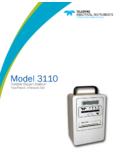Transcription of Global forest land-use change 1990-2005 - Home | …
1 I3110E/1 978-92-5-107399-5 ISSN 0258-61509789251073995 ISSN 0258-6150 This report presents the key findings on forest land use and land -use change between 1990 and 2005 from FAO s 2010 Global forest Resources Assessment Remote Sensing Survey. It is the first report of its kind to present systematic estimates of Global forest land use and ambitious goal of the Remote Sensing Survey was to use remote sensing data to obtain globally consistent estimates of forest area and changes in tree cover and forest land use between 1990 and 2005 . Overall, it found that there was a net decrease in Global forest area between 1990 and 2005 , with the highest net loss in South America. While forest area increased over the assessment period in the boreal, temperate and subtropical climatic domains, it decreased by an average of million hectares annually in the tropics. The survey estimated the total area of the world s forests in 2005 at billion hectares, or 30 percent of the Global land report is the result of many years of planning and three years of detailed work by staff at FAO and the European Commission Joint Research Centre, with inputs from technical experts from more than 100 countries.
2 Many of these contributors now constitute a valuable Global network of forest remote sensing and land -use FORESTRY PAPER169 169 FAOFORESTRYPAPERG lobal forest land -use change 1990 2005 Global forest land -use change 1990 2005 Global forest land -use change 1990 2005 Cover photos:Left: Western hemlock, Tsuga heterophylla natural forest , Alaska (B. Ciesla)Centre: RGB composition (Band 5, 4 and 3) from Landsat 7, over a 20km by 20 km tile located at 72 West and 38 South, Chile ( geological survey)Right: forest cleared for agriculture, Thailand (FAO/14639/K. Boldt)food and agriculture organization of the united nationsRome, 2012 FAO FORESTRYPAPER169byerik J. lindquist, r mi d annunzio, adam gerrand, Kenneth Macdicken, fr d ric achard, ren Beuchle, andreas Brink, hugh d. eva, Philippe Mayaux, Jes s san-Miguel-ayanz and hans-J rgen stibigGlobal forest land -use change 1990 2005 Please cite as: FAO & JRC. 2012. Global forest land -use change 1990 2005 , by Lindquist, R.
3 D Annunzio, A. Gerrand, K. MacDicken, F. Achard, R. Beuchle, A. Brink, Eva, P. Mayaux, J. San-Miguel-Ayanz & H-J. Stibig. FAO Forestry Paper No. 169. Food and Agriculture Organization of the United Nations and European Commission Joint Research Centre. Rome, designations employed and the presentation of material in this information product do not imply the expression of any opinion whatsoever on the part of the Food and Agriculture Organization of the United Nations (FAO) concerning the legal or development status of any country, territory, city or area or of its authorities, or concerning the delimitation of its frontiers or boundaries. The mention of specific companies or products of manufacturers, whether or not these have been patented, does not imply that these have been endorsed or recommended by FAO in preference to others of a similar nature that are not document has been produced with the financial assistance of the European Commission.
4 The views expressed herein can in no way be taken to reflect the official opinion of the European Commission. Should users find any errors in the document or would like to provide comments for improving its quality they can write to 978-92-5-107399-5 All rights reserved. FAO encourages reproduction and dissemination of material in this information product. Non-commercial uses will be authorized free of charge, upon request. Reproduction for resale or other commercial purposes, including educational purposes, may incur fees. Applications for permission to reproduce or disseminate FAO copyright materials, and all queries concerning rights and licences, should be addressed by e-mail to or to the Chief, Publishing Policy and Support Branch, Office of Knowledge Exchange, Research and Extension, FAO, Viale delle Terme di Caracalla, 00153 Rome, Italy. FAO 2012 iiiContentsAcknowledgements viiForeword viiiAcronyms and abbreviations ixExecutive summary x1.
5 Introduction 1 The fra 2010 remote Sensing Survey 12. Methods and materials 3 land cover and land use 3 Systematic sample design 3 Imagery data sources 4 Image preprocessing 4automated land -cover classification 4 Training the classification 6 land -use classes 8 Conversion of land cover to land use 9 Expert interpretation, validation and correction of land cover and land use 103. Data analysis 11No data 11adjustment for latitude and area weighting 11aggregation for regional and climatic domain analysis 12forest area: gains and losses 12annualizing forest -area change 13 Error 144. Results and discussion 15 The area in forest land use declined between 1990 and 2005 16 Global forest loss and gain 16regional differences in forest loss and gain 16 Differences in the annual rate of change by region and climatic domain 19 Comparison with other faO studies 19 Causes of land -use change 24accuracy assessment 255.
6 Conclusion 27 Integration of coarse resolution satellite imagery to help classification 27 Importance of visual review and revision of classification 27 The utility of LaNDSaT for Global monitoring 27 Establishment of Global networks 28ivReferences 29 Annex 1. Country-specific review-and-revision methodologies 33 Annex 2. Survey sites processed vs analysed 35 Annex 3. Review-and-revision contributors 37 Annex 4. Details of calculation 39vFigures1 The 15 779 1-degree grid sample site locations used in the survey, with reduced intensity above 60 latitude north and south 32 Example of three imagery dates combined to make a single composite image with segments that capture reflectance changes in each period 53 Generalized flowchart of the faO processing chain 74 land -cover and land -use classes and their associated numeric codes 95 JrC validation tool user interface showing Landsat imagery from each survey period (left) and faO land -use classes (centre) 106 final 13 066 sites used in rSS 2010 analysis 117 regions (a) and climatic domains (b)
7 Used for aggregation and analysis 128 range of dates of satellite imagery used for each survey period 139 forest area by region, 1990, 2000 and 2005 1710 forest area by climatic domain, 1990, 2000 and 2005 1711 Gross gains and losses and net changes in forest area, by fra region, 1990 2000 and 2000 2005 1812 Gross gains and losses and net changes in forest area, by faO climatic domain, 1990 2000 and 2000 2005 1813 Distribution of sample points, pantropics, rSS 2000 2014 Pantropical forest area for 1990 (a) and 2000 (b), as estimated in rSS 2000 and rSS 2010 2015 Pantropical net annual forest area change between 1990 and 2000, as estimated in rSS 2000 and rSS 2010 2116 Pantropical forest area in 1980, 1990, 2000 and 2005 2117 a comparison of forest area, by region, as reported in fra 2010 and rSS 2010 2218 relationship between proportion of dry climatic domains per region and the proportional difference between fra 2010 and rSS 2010 forest area estimates for that region 2319 Net change in forest area, rSS 2010 compared with fra 2010 24 Tables 1 Level-2, 5-ha MMU land -cover labelling scheme based on the percent composition of underlying level-1 segments, listed in descending order of priority 62 Mean forest area ( 000 ha standard error) by region (a) and climatic domain (b)
8 , 1990, 2000 and 2005 133 Significance of net annual changes and gross annual gains and losses for regions and climatic domains 154 P values for the slope of the line formed by a general linear model relating annualized net change and gross gains and losses with survey period by regions and climatic domains 155 aNOVa test for annual net forest area change , by climatic domain and year 166 rEML results for annual net change by climatic domain and survey period (1990 2000 and 2000 2005 ) 167 Mean annual net forest area change and 95 percent confidence intervals between survey periods for faO regions and faO climatic domains 17viiAcknowledgementsFAO and the European Commission Joint Research Centre (JRC) prepared this report on the Global forest Resources Assessment (FRA) 2010 Remote Sensing Survey in partnership, and they express thanks for the assistance and input of many organizations, countries, donors, other partners and individual experts.
9 The major contribution to operational funding for the FRA 2010 Remote Sensing Survey for the period 2009 11 was made by the European Commission. Other support was provided through initial grants from the National Aeronautics and Space Administration, the Heinz Center, the Government of Australia and the Government of following governments are thanked for their contributions of extra-budgetary financial resources or secondments: those of Australia, Brazil, France, Norway and the United States of than 200 national-level forestry and remote sensing experts collaborated on this report, both directly and indirectly; they are listed in Annex 3. This collaboration was critical to the success of the FRA 2010 Remote Sensing Survey and is gratefully authors wish to thank the following FAO staff members for their contributions: Mette L yche-Wilkie, Renato Cumani, Antonio Di Gregorio, Emma Foti, Monica Garzuglia, Stefano Giaccio, rjan Jonsson, John Latham, Antonio Martucci, Marisalee Palermo, Anssi Pekkarinnen and Ilaria Rosati.
10 Several FAO consultants were also involved: Ralph Ridder advised on sample design, Marieke Sandker reviewed thousands of remote sensing samples and assisted with database management, and Susan Iremonger updated maps of climatic domains. The authors would also like to thank the following members of the JRC and its collaborator, the University of Louvain-La-Neuve, for their contributions: Catherine Bodart, Silvia Carboni, Pierre Defourny, Fran ois Donnay, C line Ernst, Desir e Johansson, Pieter Kempeneers, Ouns Kissiyar, Andrea Lupi, Rastislav Ra i, Roman Seliger, Dario Simonetti, Fernando Sedano, Lucia Seebach, Peter Strobl, Astrid Verheggen, Peter Vogt, Michael Vollmar and Carlos de Loveland and staff at the United States Geological Survey assisted in obtaining the large quantities of Landsat data required for the FRA 2010 Remote Sensing Survey. Matt Hansen, Peter Potapov and Anil Kommareddy (South Dakota State University) assisted with the preprocessing of the Landsat data used by FAO.
















